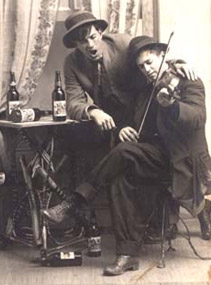In A New Religion in Mecca: Memoir of a Renegade Brewery in St. Louis, among the many topics Tom Schlafly touches on are workingmen and the image of beer (maybe that’s just one topic).
in St. Louis, among the many topics Tom Schlafly touches on are workingmen and the image of beer (maybe that’s just one topic).
Schlafly, whose Saint Louis Brewery opened as a brewpub in 1991 and grew into a regional brewery, makes a fine point about the price of beer (and thus adds to the discussion about cheap beer) in a pub.
I am constantly mindful that customers in bars and restaurants willingly pay nearly three times as much for a glass of beer as the same amount of beer would cost in a supermarket. Considering that they could be drinking the same beer at home for nearly two-thirds les, what do bars and restaurants offer that’s worth such a premium?
 And who drinks Schlafly beer? The question is particularly relevant in St. Louis, where drinkers are understandably loyal to Anheuser-Busch and the union workers who work in its factories. When Saint Louis Brewery decided to sell bottled beer in 1996, Schlafly and his partners had good reason to look at their branding, and reconsider the elegant Swiss-looking logo they had chosen for their taproom.
And who drinks Schlafly beer? The question is particularly relevant in St. Louis, where drinkers are understandably loyal to Anheuser-Busch and the union workers who work in its factories. When Saint Louis Brewery decided to sell bottled beer in 1996, Schlafly and his partners had good reason to look at their branding, and reconsider the elegant Swiss-looking logo they had chosen for their taproom.
Core, a local advertising agency, quickly took them to task. One of agency’s owners explained yuppies would buy products with a blue collar image, but blue collar workers wouldn’t buy products with a yuppie image. The issue didn’t have to be money. A bricklayer wouldn’t think of buying a Volvo, but would spend more money on a Dodge Ram pickup.
We acknowledged that there were those who regarded beer from microbreweries as “designer beer,” just as Evian was derided as “designer water.” The purveyors of such products were seen as duping consumers into paying exorbitant prices for something that wasn’t any better than the more reasonably priced mainstream version. We therefore made the conscious decision to position Schlafly as a traditional beer for everyone, not as a drink primarily for pretentious, overeducated elitists. We adopted the slog “Beer the way it used to be” as a means of underscoring this message.
The photo of a case box (above) gives you an idea of the result. This isn’t a matter of a brewery trying to “fool” customers. Schlafly writes, “We wanted every aspect of the package to remind consumer that we were offering beers that the mainstream breweries were no longer interested in making.”
Beers that workingmen drank more than a century ago.
Now, about the book itself. Even if you keep a beer at your side throughout you should be able to walk and talk when you are done reading. Schlafly writes in an engaging style and the book is just over 100 pages, without most of the business detail in recent books such at Beer School (Brooklyn Brewery) and Brewing up a Business
(Brooklyn Brewery) and Brewing up a Business (Dogfish Head Brewery).
(Dogfish Head Brewery).
I must note, though, that the book is much more entertaining if you already know the city of St. Louis, the Saint Louis Brewery and its two pubs, and particularly any of the people who work there.
Schlafly writes, “When we founded the Saint Louis brewery, we seemed to attract people steeped in liberal arts. faithful to the medieval preference for artes liberales over artes illiberales, almost no one had had any training that could be consider practical or useful when it came to operating a brewery.
Sixteen years later many of those same people are still there. Working men and women everyone.
 All the best ideas end up with beer.
All the best ideas end up with beer. And who drinks Schlafly beer? The question is particularly relevant in St. Louis, where drinkers are understandably loyal to Anheuser-Busch and the union workers who work in its factories. When Saint Louis Brewery decided to sell bottled beer in 1996, Schlafly and his partners had good reason to look at their branding, and reconsider the elegant Swiss-looking logo they had chosen for their taproom.
And who drinks Schlafly beer? The question is particularly relevant in St. Louis, where drinkers are understandably loyal to Anheuser-Busch and the union workers who work in its factories. When Saint Louis Brewery decided to sell bottled beer in 1996, Schlafly and his partners had good reason to look at their branding, and reconsider the elegant Swiss-looking logo they had chosen for their taproom.